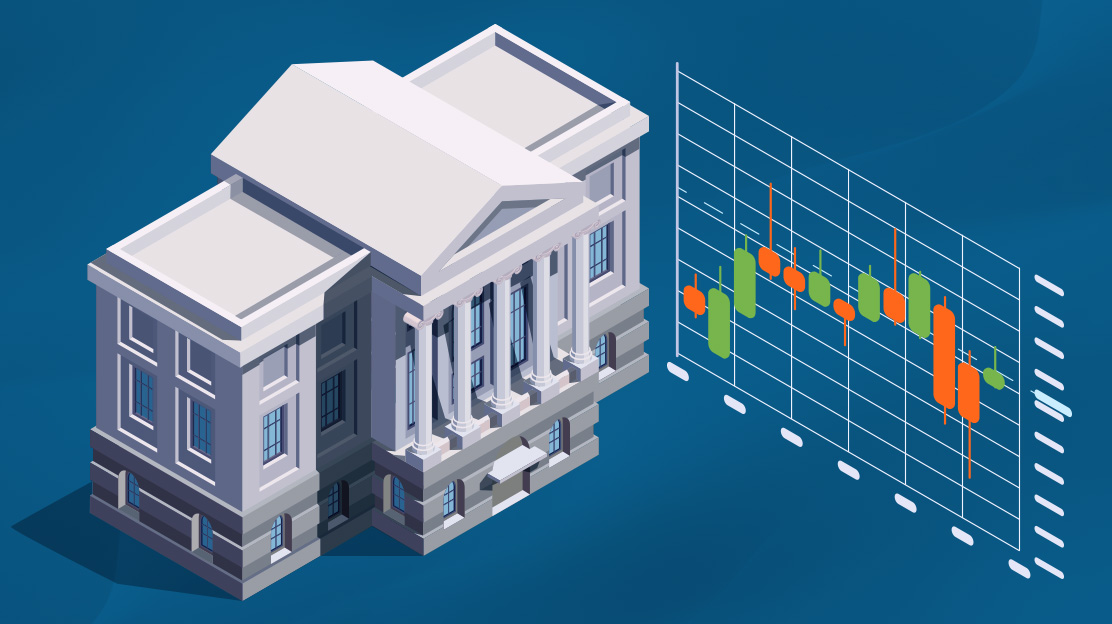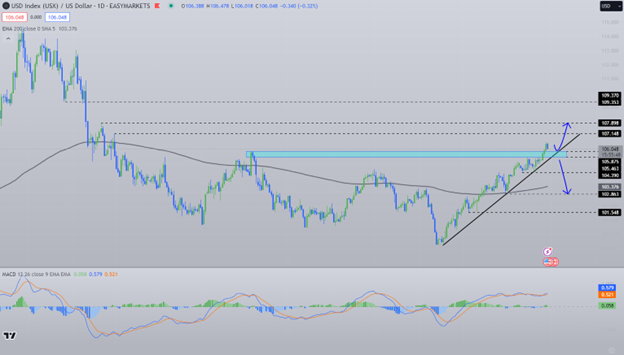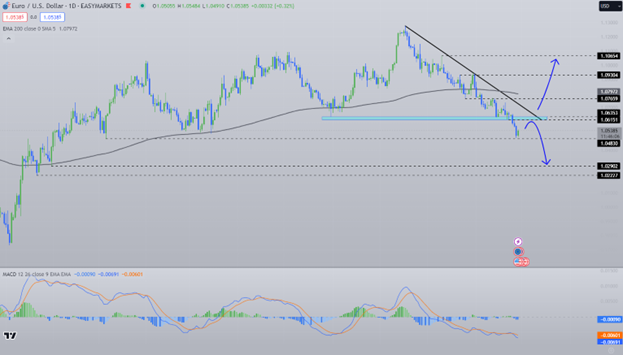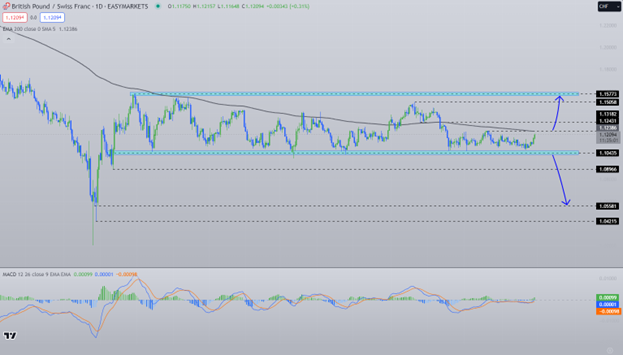
In September, we saw most of the central banks of the developed countries holding off from raising rates further. They have decided to take a wait-and-see approach to determine if inflation is under control. Only the ECB decided to go for a rate hike, stating that more tightening is needed. However, we can see that all those central banks have one thing in common: the readiness to act if economic data sets become unfavorable for their domestic economies.
Federal Reserve
During the September meeting of 2023, the US Federal Reserve decided to keep their interest rates in the range between 5.25% and 5.50%, as inflation seems to be under control. That said, the Fed signaled another rate hike before the end of this year; at least, this is what the revised dot plot showed. For now, the expectation is to see another rate hike in 2023 and two cuts in 2024. In addition, the FOMC members revised the average interest rate to 5.10%, 50 bps higher than June’s estimates. The economic projections released in September show some positivity from the board members across most metrics. In 2024, the committee expects real GDP to be around +1.5% against the previously expected +1.1%. Unemployment is forecasted to drop to 4.1%, against the initial June estimate of 4.5%. However, the core and headline PCE readings are expected to remain the same, at +2.6% and +2.5%, respectively.
A higher interest rate environment is putting pressure on the stock market, making it less attractive to invest in. Also, such Fed actions are making the way for the US dollar to strengthen against its major counterparts, meaning it can help lower inflation. However, that would increase the trade deficit, as US-made goods would be less attractive on the global market. This means more goods would be imported into the country, putting pressure on local producers.
DXY – Technical Short-Term Outlook
From around mid-July, we saw DXY grinding higher while trading above a short-term upside support line drawn from the low of July 18th. After breaking one of its key resistance areas, between the 105.46 and 105.87 levels, the index continues to remain under buying interest overall.
Even if the price corrects back down a bit, as long as it remains above the aforementioned upside line, we will remain positive at least with the short-term outlook. A rebound from that upside line could send DXY towards the 107.15 zone, marked by the high of November 30th, 2022. If that zone cannot withstand the pressure from the bulls, the next possible target could be 107.90. That area is marked near the high of November 21st, 2022.
Alternatively, a break below the previously mentioned upside line could signal a change in the direction of the short-term trend, possibly opening the door for a move to the 104.39 hurdle, which is marked near the lows of September 11th and 20th. We will then target the 200-day EMA, or the 102.86 obstacle. That obstacle is marked by the low of 30th of August.

European Central Bank
In September, the eurozone delivered its inflation numbers for August, which showed a slight decline compared with the previous readings. The headline YoY CPI came out as a slight surprise, at +5.2% against the forecasted and previous +5.3%. After that, the ECB hiked interest rates for the 10th consecutive time on September 14th and signaled that it is likely done with tightening policy, as inflation has started to decline but is still expected to remain elevated. Therefore, the main refinancing operations rate touched a 22-year high of 4.5%, and the deposit facility rate set a record at 4%. According to the September ECB staff macroeconomic projections for the Euro Area, average inflation is forecasted to be at 5.6% in 2023 and 3.2% in 2024, both higher than previous estimates, primarily due to rising energy prices.
In contrast, the 2025 inflation rate projection has been cut to 2.1%. Furthermore, there have been slight downward revisions to the expected trajectory for core inflation, with an average of 5.1% in 2023, 2.9% in 2024, and 2.2% in 2025. The central bank has also significantly reduced its GDP growth projections, anticipating the economy to expand by 0.7% in 2023, 1.0% in 2024, and 1.5% in 2025. Although the ECB said that they are done with the rate hikes, we have understood from Christine Lagarde’s press conference that they will remain data dependent.
EUR/USD – Technical Short-Term Outlook
We have mentioned above that DXY has been grinding higher since around mid-July. EURUSD, on the other side, has been drifting lower from around the same time while trading below a short-term downside resistance line taken from the high of July 18th. Recently, the pair broke below strong support area, between the 1.0615 and 1.0635 levels. Those levels mark the current lowest point of 22nd of September and the lowest point of May, respectively.
Given that we already saw quite an extensive slide over the period of a couple of months, we may see a corrective move back up. If the rate rises, but struggles to break above the previously discussed downside line, this may result in the bears taking advantage of the higher rate, possibly sending the pair lower again. EURUSD might travel back to the 1.0483 hurdle, marked by the current lowest point of this year. If that hurdle gets violated, this would confirm a forthcoming lower low, also setting a new low for the year. That’s when we will start targeting the 1.0290 level, marked by the low of 30th of November 2022.
On the other hand, a break of the aforementioned downside line could allow the bulls to step in, as such a move may signal a change in the direction of the short-term trend. We will then aim for the 1.0766 obstacle, a break of which might clear the way to the 1.0930 territory. That territory is near the highs of 22nd and 31st of August. If the buying doesn’t stop there, the next possible target might be at 1.1065, which is the highest point of August.

Bank of England
On September 21st, the Bank of England delivered its interest rate decision, where they kept it at +5.25%. This decision was a surprise, as the expectation was for the number to be 25 bps higher. Policymakers decided to take the wait-and-see approach, which, to be honest, has been around for a while, as many central banks have taken that course. This development occurred the day before Britain delivered its CPI figures for August. The headline and core figures came as a surprise, below the initial forecasts. This drop in inflation might have played a key role in keeping the rate the same as previous. Although the rate is still the highest it has ever been since the beginning of 2008, this pause in hiking rates has been the first one since November 2021. The Monetary Policy Committee voted 5 to 4 in favor of keeping rates steady. If inflation starts shifting to the downside rapidly, this may even force the BoE to rethink the hiking idea by switching to cuts.
GBP/CHF – Technical Short-Term Outlook
Looking at the technical picture of GBPCHF on our daily chart, we can see that from around the end of October 2022, the pair has been moving sideways, roughly between the 1.1040 and 1.1577 levels. Although we can see that the rate is stuck in a range from around mid-July, GBPCHF cannot get back above the 200-day EMA. Nevertheless, in order to consider the next short-term directional move outside of that range, a break through one of the sides of it would be needed.
A break above the 1.1243 barrier, marked by the highest point of August, could also place the pair above the 200-day EMA. Such a move could attract more buying interest, possibly sending the rate higher within the given range. We would then aim for the 1.1318 obstacle or even the 1.1505 zone, marked by the highest point of June. Slightly above that zone lies the upper bound of the previously discussed range, at around 1.1577, which might also get tested.
If the lower bound of the range surrenders and the rate falls and stays below the 1.1040 zone, this may spook the remaining bulls from the field for a bit, potentially opening the door for a further slide. This could send GBPCHF to the 1.0897 zone, which is the lowest point of October 2022. If the selling continues, we will then start aiming for the 1.0558 level, marked by the inside swing low of September 27th, 2022.

Bank of Japan
On Friday, September 22nd, the Bank of Japan was the last of the central banks to deliver interest rate decisions that week to keep rates unchanged. However, unlike other banks, the forecast was already set for the same figure to come out as before, at -0.10%. Japan’s central bank noted that it could continue with its monetary easing tactics by responding to the financial conditions and economic activity both domestically and abroad. The BoJ continues to pursue its inflation target of 2% sustainably. Let us remind our readers that Japan’s current inflation numbers sit at +3.20%. Governor Kazuo Ueda recently said that negative interest rates could end sooner than expected if wage data support this. From the beginning of this year, the Japanese yen has been depreciating against most of its major counterparts. This depreciation may force the BoJ to step in to save the Japanese currency from further depreciation.
USD/JPY – Technical Short-Term Outlook
Overall, USDJPY continues to move higher while trading above a medium-term upside support line taken from the low of March 24th 2023. The pair had recently broken above a resistance barrier at 148.85, which is the high of October 31st 2022. Given the strong upside move, which we already saw, there could be a small correction lower, before another possible leg of buying.
If the pair corrects lower, but remains somewhere above the 148.85 barrier, this might keep the bulls interested for a while. If that the case, USDJPY may rebound and make its way back up, possibly aiming for the 150.28 hurdle, which is the high of October 20th 2022. If we still do not see any intervention from the BoJ, USDJPY may continue its journey north, possibly targeting the 151.95 area, marked near the highest point of October 2022.
Alternatively, a drop below the 147.32 hurdle, marked by the low of September 21st, could invite more bears into the game. If so, this could lead the pair towards a larger correction lower. We would then aim for the 145.90 obstacle or even the 144.54 territory. That territory is marked near the lows of August 23rd and September 1st. Slightly below it, we have the 143.90 support area, marked by the inside swing high of August 3rd, which may also get tested. Around there, the rate could test the previously discussed upside line that might provide additional support.
USD/JPY – Technical Short-Term Outlook
Reserve Bank of Australia
On September 5th, the Reserve Bank of Australia decided to keep their cash rate the same as previous, at +4.10%. This decision was already widely expected even before the decision. It was the third month in a row where they kept the rate unchanged. The RBA thought that the rates have already been raised substantially and wanted to give inflation more time to adjust to that before jumping in with another hike. That said, during the last bank meeting, the committee expressed their readiness to step in with more hikes if inflation starts picking up the pace to the upside. The RBA has their inflation target set in the area between 2% and 3%. At the time of writing, Australia’s inflation sits at +6.00%.
AUDJPY – Technical Short-Term Outlook
From around the end of March of this year, AUDJPY has been on a gradual upmove, while trading above a medium-term upside support line drawn from the low of March 24th. That said, after peaking around mid-June, the pair corrected slightly lower but remained above that upside line. We can see that the rate is currently testing the area near a key resistance barrier, at 95.86, marked near the highs of 25th and 31st of July.
If, eventually, that resistance barrier surrenders, this may invite more bulls into the field. Such a move could open the horizon to slightly higher areas, which might get tested. We will initially aim for the 96.83 hurdle, a break of which may open the door for a move to the current highest point of this year, at around 97.68 zone. If that zone surrenders to the bulls, this will create a new high for this year and may clear the path towards the 98.65 area, marked by the highest point of September 2022.
On the downside, a break of the previously mentioned upside line could signal a change in the direction of the current short-term trend, especially if the rate also falls below the 94.54 hurdle, marked by the low of September 22nd. That’s when we will start targeting the 93.59 obstacle or even the 92.79 level. That level marks the lowest point of August. If the bears stay in control, the next possible target might be at around 91.80, which is near the lowest point of July.
